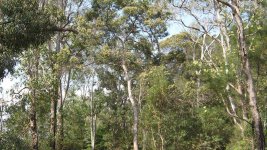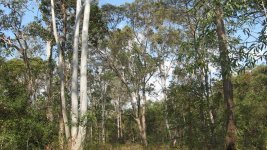W
wilbur
more Wattles
more Wattles
These two images show a different type of Wattle to those varieties previous posted to 'organic fanatics'. As High Country has said Wattles germinate rapidly after a fire. When this happens at my place the variety shown here will sometimes germinate in places that are unsuitable for its long term growth. At first the seedlings grow rapidly in the fresh char and small patches of loose soil or sand. But because the soil in these places is heavy, this type of wattle fails to grow to any size. They survive in thickets as stems sometimes up to thirty feet high that are rarely larger than 50mm – 75mm. These thickets are what I 'm weeding out at present with the chainsaw.
The first of these images shows a Wattle with a trunk (at chest height) of five and a half hand spans around. It is about fifty feet high. The second image shows a tree with a trunk of eight hand spans around. It is only a bit higher than the first tree but has many more branches.
The shape of wattle in the second pic is due to fire damage. The tree is bent in the direction the fiercest fire. (Fire has shaped the Eucalyptus you can see too. The light coloured Eucalyptus are what the locals call 'blue gum'. Down south I hear they're called 'river red gum'.)
In some places these Wattles will grow with a clear straight trunk. Sometimes higher than many of the hard-country Eucalyptus near it. But the wood is useless for construction or sawing because it lacks any fibrous quality.
It doesn't take much of a fire or a dry spell to make these wattles drop a blanket of leaves on the ground. As I 've said, good rain shortly after a fire will see these wattles grow rapidly. I 'm thinking the tree in the second picture probably demonstrates how rapidly this type of Wattle can grow. You can see most of a branch about thirty feet long sprouting horizontally from its lower trunk. So I think it's unlikely a horizontal branch could get as long as this one is unless growth at the time was rapid.
When large these Wattles may become a dangerous tree. They have a shallow root system. And a mature tree must weigh a few tons which means a lot of work if one falls across the driveway.
I 've never seen insect eating birds feed from these Wattles or any bird nesting in them. In good seasons these trees produce a magnificence of flowers but little honey can be gathered from them.
Otherwise this Wattle is a very important tree around the sandy creeks here. It is short lived … from what I have learned from the locals here, less than 80 years. It grows quickly, to first shade the ground, then to store water and feed the ground with its leaves. When the trunk is dead it soon falls over and provides a rotting, damp environment for insect larvae.
Then, mostly Echidnas around here, feed on the larvae ... and on and on Nature goes. Which suits me!
more Wattles
These two images show a different type of Wattle to those varieties previous posted to 'organic fanatics'. As High Country has said Wattles germinate rapidly after a fire. When this happens at my place the variety shown here will sometimes germinate in places that are unsuitable for its long term growth. At first the seedlings grow rapidly in the fresh char and small patches of loose soil or sand. But because the soil in these places is heavy, this type of wattle fails to grow to any size. They survive in thickets as stems sometimes up to thirty feet high that are rarely larger than 50mm – 75mm. These thickets are what I 'm weeding out at present with the chainsaw.
The first of these images shows a Wattle with a trunk (at chest height) of five and a half hand spans around. It is about fifty feet high. The second image shows a tree with a trunk of eight hand spans around. It is only a bit higher than the first tree but has many more branches.
The shape of wattle in the second pic is due to fire damage. The tree is bent in the direction the fiercest fire. (Fire has shaped the Eucalyptus you can see too. The light coloured Eucalyptus are what the locals call 'blue gum'. Down south I hear they're called 'river red gum'.)
In some places these Wattles will grow with a clear straight trunk. Sometimes higher than many of the hard-country Eucalyptus near it. But the wood is useless for construction or sawing because it lacks any fibrous quality.
It doesn't take much of a fire or a dry spell to make these wattles drop a blanket of leaves on the ground. As I 've said, good rain shortly after a fire will see these wattles grow rapidly. I 'm thinking the tree in the second picture probably demonstrates how rapidly this type of Wattle can grow. You can see most of a branch about thirty feet long sprouting horizontally from its lower trunk. So I think it's unlikely a horizontal branch could get as long as this one is unless growth at the time was rapid.
When large these Wattles may become a dangerous tree. They have a shallow root system. And a mature tree must weigh a few tons which means a lot of work if one falls across the driveway.
I 've never seen insect eating birds feed from these Wattles or any bird nesting in them. In good seasons these trees produce a magnificence of flowers but little honey can be gathered from them.
Otherwise this Wattle is a very important tree around the sandy creeks here. It is short lived … from what I have learned from the locals here, less than 80 years. It grows quickly, to first shade the ground, then to store water and feed the ground with its leaves. When the trunk is dead it soon falls over and provides a rotting, damp environment for insect larvae.
Then, mostly Echidnas around here, feed on the larvae ... and on and on Nature goes. Which suits me!
















